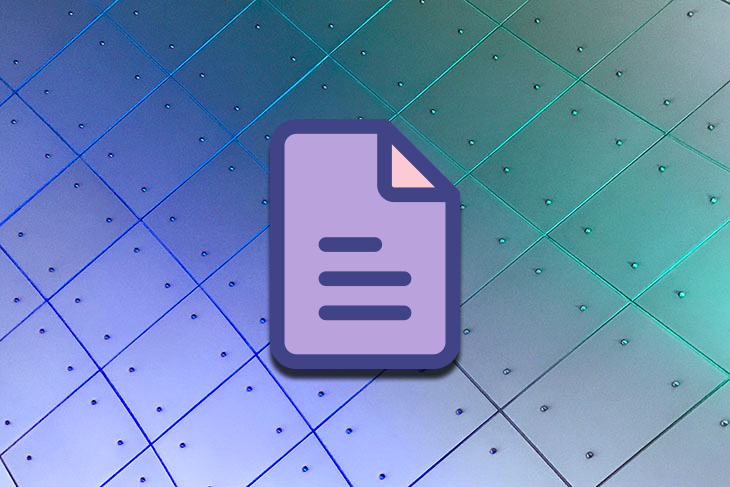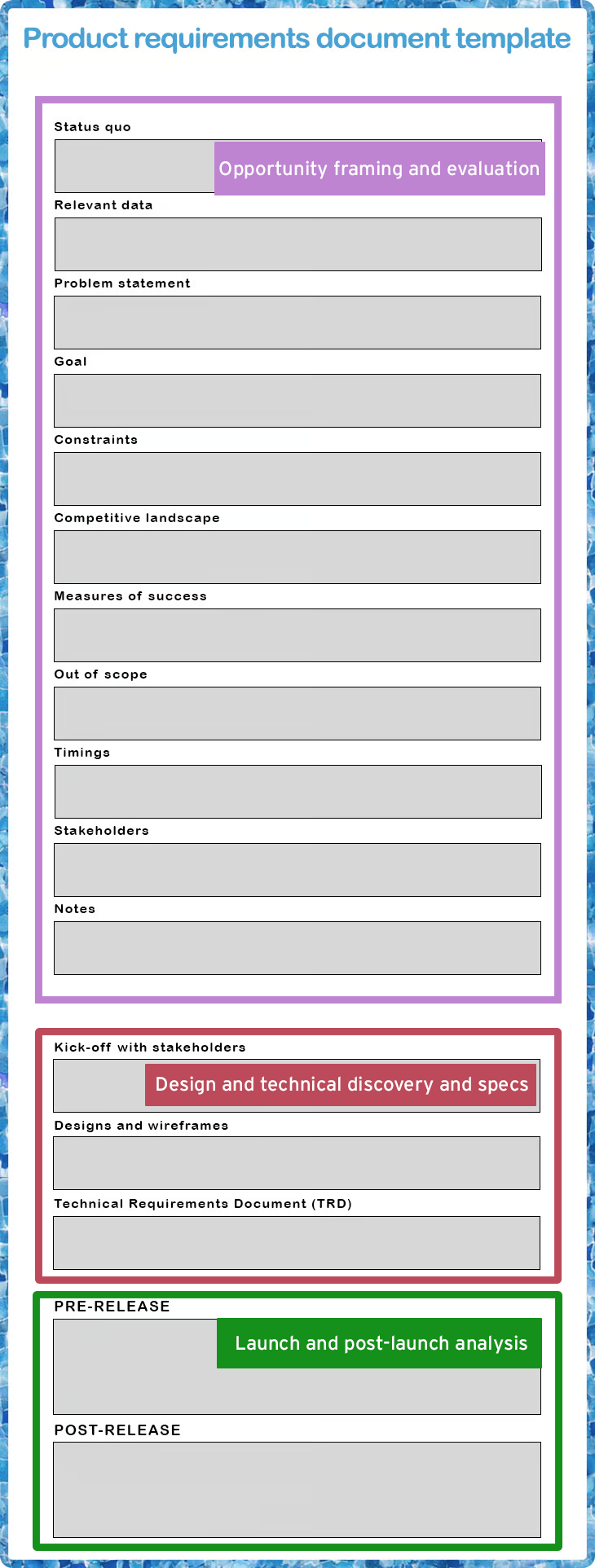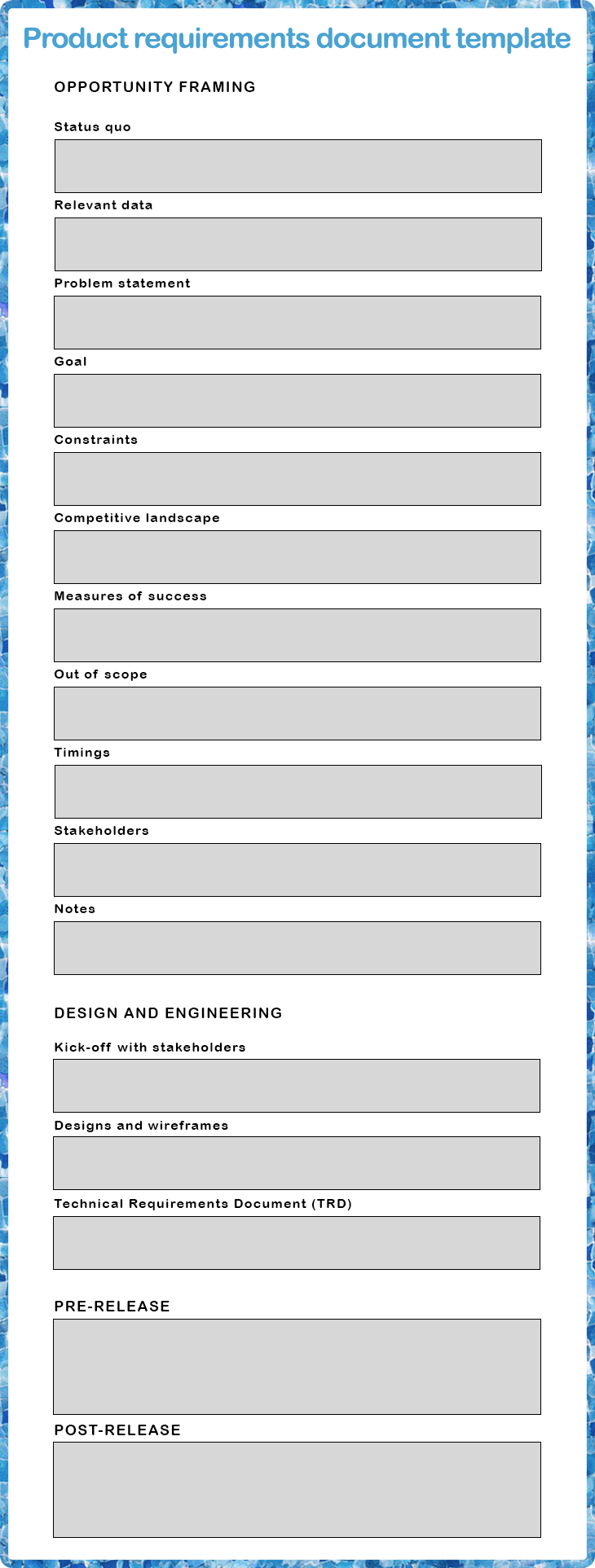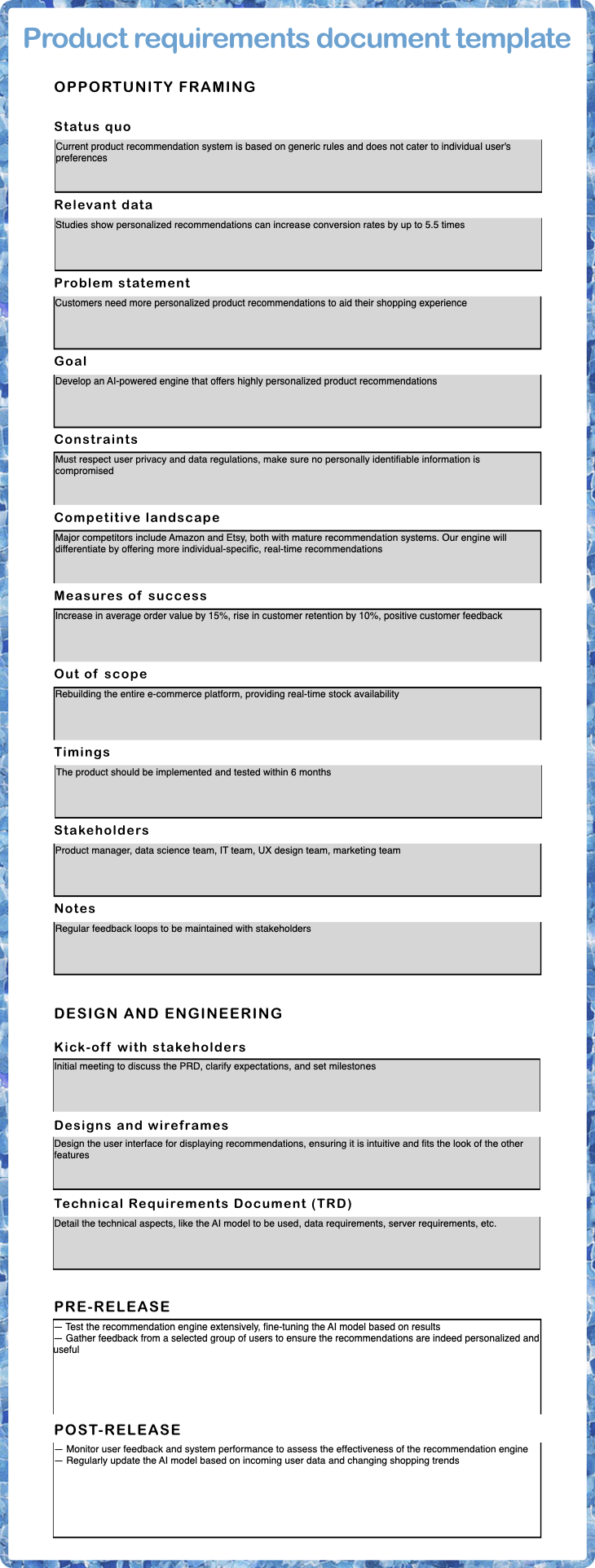Editor’s note: This article was most recently reviewed and updated on 2 October 2024. Updates to this post since its initial publication include a clearer definition of PRDs, more information regarding the importance of PRDs, who creates and uses them, what they are used for, and to give a specific example using the provided template.

PRD, which stands for product requirements document, outlines the requirements of a product. It typically includes:
In this guide, we’ll explain why you need a product requirements document (PRD) to align your team on a problem statement, KPIs, and other criteria for delivering a product or feature.
We’ll also break down the contents of a typical product requirements document and provide a practical example that you can use as a template when outlining your own PRDs.
A product requirements document (PRD) acts as a strategic document that outlines the purpose, features, functionality, and behavior of a product that is going to be developed. It helps serve as a reference point so everyone from general stakeholders to the developers building the product are aligned on how it’s going to work.
By “product,” in the context of the PRD, we generally mean a digital product. More often than not, we mean only part of a digital product (an improvement, feature, or set of features). And by “requirements,” we refer not only to the acceptance criteria that you would usually find in a Jira ticket, but also to other elements such as a problem statement, measures of success, or a go-to-market strategy.
Usually, a product manager will write a PRD and use it to communicate with stakeholders involved in developing and launching the product. This helps align everyone with regard to the product’s purpose, along with its technical and logistical requirements.
While PRDs are often used in waterfall and agile product development, they can also be helpful outside of these contexts.
The waterfall methodology offers a linear approach to product development. Since waterfall projects typically have clear, unchanging requirements, the PRD provides a comprehensive and detailed blueprint that guides your team through each sequential stage with minimal changes mid-project. This helps keep the team on schedule while preventing scope creep.
Agile environments are usually more flexible and dynamic, so a PRD in this setting may also be less formal, more of a living document than a rigid blueprint. Since agile teams iterate based on feedback, they may adapt the PRD accordingly or even break it down into smaller, actionable items, like user stories or epics. Your team can refer back to the PRD for high-level product goals, features, acceptance criteria, and other essential information while staying agile.
Outside of waterfall and agile settings, PRDs can still provide a helpful roadmap for product teams. You can adapt the PRD to stakeholder needs and your work or company culture, helping the team get and stay on the same page throughout the product’s development and launch.
Product requirements documents act as a bridge between what stakeholders — like the product management team, engineers, marketers, C-suite executives, etc. — envision for the product and what the development teams can realistically execute. Without PRDs, it’s possible that the stakeholders are thinking one thing and developers are thinking another. PRDs prevent any of these mixups early so everyone is on the same page.
For the development team specifically, a PRD clearly identifies what features are expected to come out of the build. It outlines how much of a priority each item is as well so the development team can split the work accordingly.
Lastly, PRDs are excellent for establishing realistic expectations and benchmarks to follow. Having a clear, measurable goal outlined in the PRD helps everyone know what they’re working towards and what to measure the feature’s performance against.
By now, we’ve established that a PRD outlines a product’s purpose, features, and functionality — all the requirements it should meet to solve a problem and meet the needs and expectations of your customers. A BRD, or business requirements document, focuses more on how the product will support business objectives and goals.
Together, the BRD and PRD tie the overall business strategy to actionable product requirements. The BRD establishes the broader business context and goals, while the PRD details how the product will be built and delivered to achieve those goals.
PRDs have a number of uses, including acting as a source of truth, guiding decision-making, driving team collaboration, and ensuring customer satisfaction. Let’s go into more depth below.
First and foremost, product requirements documents can be used as the source of truth for both stakeholders and tech teams. In fact, when done correctly, they can be used throughout the entire product development process and serve as the backbone for project management that comes along with it.
In layman’s terms, you will use the PRD to help you structure all the information around the product to make it easier to explain and understand.
Another valuable outcome of having a well-built PRD is that the product manager, the person responsible for making sure the team works on the highest-impact topics, will have an easier time deciding whether the problem described in the PRD really brings the highest value.
Teams are the most collaborative when they’re all working towards the same known goal. PRDs make this easy by detailing the vision and goal for everyone.
For example, developers get a clear sense of the product’s functional requirements from the PRD, while designers will understand the user experience aspects. Marketing and sales will have insight into the product’s unique selling points (USPs) and prepare to market it and sell it based on those.
PRDs help ensure customer satisfaction. Though it’s not totally guaranteed that customers will be happy, PRDs list out the problems that the product (or feature, etc.) is going to solve and the value it’ll provide. Including user stories and specific scenarios reinforce the users and their needs, creating a product that truly resonates with them and leads to their satisfaction with it.
In very broad strokes, there are three parts to a product requirements document:
The PRD template below is organized around these three components:

Let’s zoom in on these three elements in more detail.
In the first stage of product discovery, you will want to agree on a few things with your team and stakeholders:
Having a single document where you explicitly state the answers to all these questions is a great way to get clarity and alignment (and buy-in) from every person involved. It will also prove invaluable as a tool to decide which of the various initiatives is the most valuable right now.
Once you’ve decided that the problem space is interesting enough (and this is by no means a trivial task), you can start moving on to the next phases of discovery and keep track of them in the PRD as well:
These questions will be answered gradually as you and your team work together during the design phase. The exact steps to include here will depend heavily on the type of product you are working on. More technical products might require less usability testing and more technical validation while consumer-facing products that rely on UX should include a few sets of usability tests to validate the designs before they’re considered ready for development.
As a rule of thumb, I usually advise product designers to come up with at least two solutions for a problem they’re trying to solve and test both solutions against each other. You can then eliminate the “losing” design (after extracting whatever good elements it had) and run another series of tests to continue improving.
The number of usability test rounds you should run is also dependent on many factors:
The sweet spot that works best, in my experience, is to run three rounds. First, a quick internal round with colleagues, and then two subsequent rounds of testing with enough time between them to fix whatever surfaces. This process should be documented in the product requirements document.
While the team is working on the design discovery, it should also be working to define the technical requirements. In some cases, there will be a separate document for those requirements, known as a technical requirements document (TRD).
I won’t go into too much detail about what the TRD entails because I am not an engineer, and because it will vary greatly depending on the product you’re working on. For a deeper dive, check out this informative video by product management luminary Josh Fechter:
In short, the TRD should be the PRD equivalent for developers. The doc should give the dev team context and an agreed-upon approach to building the tech part of the solution. This also includes how the tech will enable the solutions that the designers have been working on. The TRD should be included or, at the very least, linked in the PRD.
It’s important to stress that the work on the design and technical solutions should be done in parallel and in close collaboration with product designers and developers. Every solution you decide to test should be technically feasible, and the only way to know that for sure is by involving developers regularly and encouraging them to participate in the usability testing.
The same goes for the technical approach used. Different approaches will have different limitations that designers should be aware of. So while the design and technical requirements might appear in separate sections within the PRD, their definition should be done in parallel, not sequentially.
The last part of the product requirements document deals with what actions should be taken to ensure that the release of the feature or product is as successful as possible. This is, by far, the section that can change the most depending on the type of product you’re working on.
For example, B2B SaaS enterprise products should put much more emphasis on security measures and how to inform and train their existing clients. Therefore, the main stakeholders there will be customer success managers. On the other hand, B2C products tend to concentrate more on how to leverage the new features for user acquisition or retention, meaning that the main stakeholder will be the marketing department.
If you’re new to a company or relatively new to a product, the best tip I can offer is to ask your stakeholders and colleagues, how did we manage the release process in the past? What went well and what didn’t? Product management has a lot of learn-by-doing to it, so don’t be afraid to make mistakes.
The very last section of the PRD should outline when and how you will check the success of the feature post-release. Questions you may ask include:
Depending on how you plan to manage the release (staged, all at once, first to selected clients, etc.), you will have to pick a different checkpoint, but the most common approach is to check one week, one month, and three months after the release. This isn’t strictly necessary, but you can also record the results of those checkpoints in the PRD. The “completed” PRD will now serve as documentation, so it makes sense to also directly include how well the feature or initiative performed there.
The PRD structure described here is my very own flavor and I’m always updating it based on the products and companies I work for, as well as input and ideas from colleagues and stakeholders. You can use my product requirements document template as a skeleton to build your own, but don’t hesitate to remove or add parts if it makes sense to you.
For an editable PDF version of this product requirements document (PRD) template, click here.

With the above template, let’s walk through an example. Since AI is all over the news and companies are trying to incorporate AI and machine learning into their products, let’s go through an example for an ecommerce product that’s looking to add personalized, AI-driven recommendations to its users:

The beauty of PRDs is that they can be customized depending on the product you’re working on. There is no right or wrong way, you just need to make sure you’re being specific enough that it doesn’t leave anything up to interpretation.
The main purpose of the product requirements document is to simplify your work as a product manager. It’s designed to make it easier to pick what is the most valuable initiative, explain it to stakeholders and get everyone on the same page, and define how to solve it and keep it documented.
Keep those outcomes as your North Star and use them to create your own style of PRD.
Featured image source: IconScout

LogRocket identifies friction points in the user experience so you can make informed decisions about product and design changes that must happen to hit your goals.
With LogRocket, you can understand the scope of the issues affecting your product and prioritize the changes that need to be made. LogRocket simplifies workflows by allowing Engineering, Product, UX, and Design teams to work from the same data as you, eliminating any confusion about what needs to be done.
Get your teams on the same page — try LogRocket today.

Most teams fail at autonomy. Learn how clear rules help product teams move faster without micromanagement.

A practical framework for PMs to use AI in ideation without sacrificing judgment, strategy, or decision quality.

A practical five minute revenue estimation method to help product managers compare ideas, drop low impact features, and prioritize smarter.

A practical guide for PMs who want to stop being bottlenecks, delegate smarter, and lead teams effectively with a clear ownership framework.